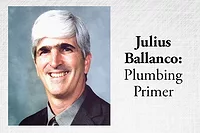Drinking Fountain, Please!
Julius Ballanco

Americans seem to be drinking more water than ever. But only a small percentage is from a drinking fountain or water cooler.
It appears that the latest status symbol is a bottle of water. You see people carrying them everywhere. Even ladies' fashion design has changed to accommodate a water bottle. Just look at the newer handbags and you will notice a pocket for a water bottle. Stop in any gym or health club, you will see people with water bottles working out on the aerobic machines.
The funniest thing for me is to watch people place a dollar or more in a machine to purchase a bottle of water, while a water cooler sits a few feet away. I guess water tastes better when you pay for it.

The plumbing codes have gotten very emphatic about the requirements for drinking fountains. The few exceptions deal with restaurants and bottled water. In a restaurant, the service of water can be substituted for a drinking fountain. In most sit-down restaurants, this has never been a problem. In fast food restaurants, it has been used to make a quick buck.
My youngest daughter, who only drinks water, will ask for water at Burger King, McDonalds, Taco Bell, etc. The first thing the cashier wants to do is ring up a bottle of water. I quickly point out that I want the free water in a glass with that order, not bottled water that I am getting ripped off for. I have never failed to get the free water.
The other exception has been that the plumbing codes will allow bottled water to be substituted for drinking fountains. The bottled water they are referring to is the big, huge bottle of water, not the individual bottles of water. The common concern is that the bottled water will disappear after a few months, and then there will be no means for obtaining drinking water.
Architects have been attempting to use other means of meeting the drinking fountain requirements that are not code approved. Some will show a refrigerator in an office kitchen area with a water dispenser. Some simply state that the kitchen sink provides an avenue for the people to obtain a glass of water.

What the plumbing codes want are good ole fashion drinking fountains or water coolers. I do, too. Unlike the bottled water tribes, I am a member of the free water society from a drinking fountain.
Some crazy environmentalists have claimed that drinking fountains and water coolers waste water since we don't catch all of the water when we drink from a fountain. I don't get overly concerned with that since a lot more water goes down the drain when we wash our hands for sanitation purposes than we lose drinking from a fountain. (Oh, I forgot, those same crazy people pass out hand sanitizer rather than washing their hands. I'm not in favor of hand sanitizers either.)
I like the sanitation of a drinking fountain or water cooler. I am appalled at the lack of sanitation when people pass water bottles amongst themselves. They wonder why they are getting sick. That is really easy to answer; they are spreading germs with their water bottles. Yuck!

Handicapped Accessible Drinking Fountains
One area that has finally been cleared up is the height of accessible drinking fountains. For many years, ADA implied that there had to be two drinking fountains, one at a low height, and one at a higher height. However, ADA only gave a dimension for the lower height.I did a survey of the drinking fountain and water cooler manufacturers to find out what they were telling the public regarding the installation height of a high drinking fountain. They all admitted that they made up the height. Interestingly, the manufacturers did not agree on this height.
The low drinking fountain was always intended to service an individual in a wheelchair. The higher drinking fountain was intended for tall people that may have back problems. It prevents them from having to lean over very far. Being 6 ft. 1 inch, I always appreciate a higher drinking fountain or water cooler.
Well, the latest edition of ANSI A117.1 has cleared up the requirement for the high drinking fountain. The distance from the floor to the spout of the drinking fountain must be between 38 and 43 inches. The lower drinking fountain can be a maximum of 36 inches above the floor to the spout.
Accessible lower drinking fountains or water coolers must also have knee clearance and toe clearance for use by an individual in a wheelchair. The manufacturers have done an excellent job of providing fixtures that will meet these clearances in the design of the drinking fountain or water cooler. You simply have to install them at the correct height. The three drawings depict the various dimensions that apply to drinking fountains.
While the architect or engineer is supposed to include the requirements for accessibility for drinking fountains and water coolers on their plans, realize that it is the contractor that is cited with the violations if the drinking fountain accessibility requirements are not met. So, keep these dimensions handy when you install an accessible drinking fountain.
And the next time you are with a group in public, remind them that the water is free. It comes out of a highly sanitary drinking fountain or water cooler, courtesy of the plumbing profession.
Links
Looking for a reprint of this article?
From high-res PDFs to custom plaques, order your copy today!







